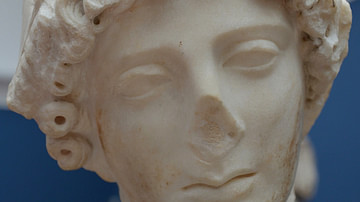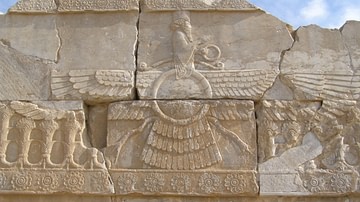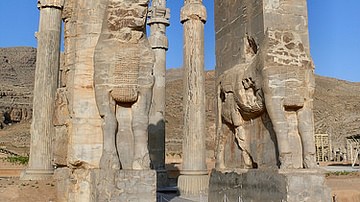Illustration
Statue of Penelope, marble copy of the bronze original, found in Persepolis in 1936, dated to c. 450 BCE.
National Museum of Iran, Tehran, acc. no. 1538
This marble torso of a seated woman in sophisticated drapes, with a height of 85 cm, was retrieved from the ruins of the Persepolis Treasury during its excavations in 1936. Her head, hands, and legs were lost, her torso broken into three pieces and found in different parts of the building. The overall signs of invasion, damage, and burning left little doubt about dating the end of the statue's usage in one piece as 330 BCE, in close connection with the sack of Persepolis by Alexander the Great.
In contrast, many questions about the so-called Penelope Statue are still under investigation. Her identity as Penelope, based on the seated position comparable to resembling statues, Roman copies, and several vase-paintings of Odysseus' faithful and patient wife, are challenged by conceivable alternatives, such as Demeter (like the one in a Parthenon frieze), Aphrodite mourning for Adonis, or Hellas waiting to be saved from the Persians by the Greeks, among others. Although it is recently confirmed that the building material of this statue is indeed the dolomitic marble from Cape Vathy-Saliara in Thasos, scholars are much less certain about the exact place of her production, since the Thasian marble was widely exported since the 6th century BCE to Sicily and the west Mediterranean as well as Asia Minor and later to the Roman Empire. Finally, most scholars agree that this remarkable Greek statue was a gift to an Achaemenid king, most likely Artaxerxes I. And yet, the supportive evidence does not seem to be conclusive enough to rule out the probability of purchase or trade as the main reason behind keeping the life-size figurine of an Archaic Greek character in the Persian royal complex of Takht-e Jamshid.
About the Author
References
- Lorenzo Lazzarini, Alessandro Poggio. "The 'Penelope' and its Marble. A Multidisciplinary Research." Rendiconti. Scienza Morali Storiche e Filologiche, s.9, vol. 28, 2017, pp. 405-423.
- Olga Palagia. "The Marble of the Penelope from Persepolis and Its Historical Implications." Ancient Greece and Ancient Iran: Cross-Cultural Encounters, 2008, pp. 223-237.
External Links
Cite This Work
APA Style
Choubineh, N. (2024, September 03). Statue of Penelope from Persepolis. World History Encyclopedia. Retrieved from https://www.worldhistory.org/image/19416/statue-of-penelope-from-persepolis/
Chicago Style
Choubineh, Nathalie. "Statue of Penelope from Persepolis." World History Encyclopedia. Last modified September 03, 2024. https://www.worldhistory.org/image/19416/statue-of-penelope-from-persepolis/.
MLA Style
Choubineh, Nathalie. "Statue of Penelope from Persepolis." World History Encyclopedia. World History Encyclopedia, 03 Sep 2024, https://www.worldhistory.org/image/19416/statue-of-penelope-from-persepolis/. Web. 23 Apr 2025.








